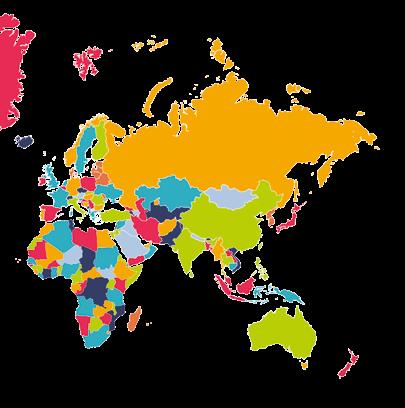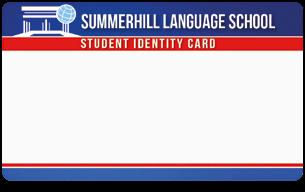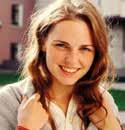
Il piacere di apprendere


Il piacere di apprendere
La didattica inclusiva in READY FOR PLANET ENGLISH PREMIUM FOR EVERYONE
Il volume Ready for Planet English PREMIUM for Everyone ripropone tutte le 15 unità dello Student’s Book riadattate in chiave inclusiva. Questi i principali accorgimenti adottati:
● utilizzo del font ad alta leggibilità con corpo 12
● separazione in paragrafi dei brani di lettura con testo numerato e riquadrato
● utilizzo di un codice colore fra le frasi chiave e le domande di comprensione corrispondenti
● utilizzo di un codice colore nella presentazione delle forme verbali per evidenziare le differenze
● utilizzo del maiuscolo nelle consegne per evidenziare il task
● utilizzo di mappe concettuali, tabelle e diagrammi nelle pagine di grammatica e lessico
● riduzione e semplificazione del numero di attività di produzione scritta e orale
La Presentation 1 è la stessa dello Student’s Book p. 42.
Il brano è stato suddiviso in paragrafi con le frasi chiave necessarie allo svolgimento dell’esercizio 4 evidenziate con dei codici colore.
I box Grammar sono stati convertiti in agili tabelle esplicative in cui il codice colore evidenzia le funzioni degli elementi grammaticali trattati.


‘al fresco’, or outside, but when the weather is good, they love having a picnic, or a barbecue!
Indica le pagine del dizionario illustrato contenute nello Student’s Book.
25
La traccia audio si trova nell’App ELI LINK o nel FLIP BOOK (libro digitale) scaricabile online utilizzando il codice che si trova all’interno della copertina dello Student’s Book & Workbook.
Barbecues are usually in people’s garden and they sometimes make a special place in the garden to cook the barbecue. These are called barbecue pits or ‘barbies’. At the beach and in local parks in the UK, there are often public barbies for people to come and cook their food on. These are free for everyone to use.
But what are British people’s favourite barbecue foods? Hamburgers seem to be number one barbecue meat in the UK, followed by sausages and chicken. For those who don’t eat any meat, the alternative is the evergreen corn on the cob, or any other vegetable like tomatoes, aubergines, courgettes or jacket potatoes. You can also grill some fruit on the barbecue such as bananas and apples with sugar and cinnamon on top.
Il numero nel box indica l’esercizio originale corrispondente nello Student’s Book.
Indica la pagina corrispondente dello Student’s Book.
Indica la sezione Grammar Bank nello Student’s Book con approfondite spiegazioni grammaticali.
Vocabulary: Colours
1 1-2 1 READ the names of the colours and MATCH them to the pictures. Then LISTEN and CHECK.
1 brown


2 green

3 orange
4 yellow

5 blue

Vocabulary:
6 white

7 pink

8 red

9 grey

10 black

Countries and nationalities

2 3 2 LISTEN and REPEAT the countries. WRITE them on the map.
Country Nationality
Mexico
America
Brazil
Italy
Spain
Britain
Poland
Turkey
China
Vietnam
3 4 Now WRITE the nationalities in the table in exercise 2.
Polish
British
Hi! I am Steve. I Y flags! What’s your favourite flag? Here are my top 10 favourites from around the world!
1 Italy is in Europe. The Italian flag is green, white and red.
2 Mexico is in Central America. The Mexican flag is green, white and red with a brown bird.
3 Britain is in Europe. The British flag is red, white and blue.
4 Turkey is in Europe and Asia. The Turkish flag is red with a moon and a star. The moon and the star are white.
5 China is in Asia. The Chinese flag is red with five yellow stars.
6 Vietnam is in Asia. The Vietnamese flag is red with one yellow star.
4 5 3 Now LISTEN, CHECK your answers and REPEAT the nationalities.
Watch out!
• Chinese
• Mexican
• American
Vietnamese
• Spanish
• Turkish • Italian Brazilian
In English we write the names of countries and nationalities with a capital letter.
5 6 4 READ and LISTEN to the text. MATCH the descriptions 1-10 to the flags A-J.
7 The United States (America) is in North America. The American flag is red, white and blue with stars and stripes. The stars are white. The stripes are red and white.
8 Spain is in Europe. The Spanish flag is red and yellow with a crest.
9 Poland is in Europe. The Polish flag is white and red.
10 Brazil is in South America. The Brazilian flag is green and yellow with a blue circle.
6 8 CIRCLE the correct alternative.
1 Britain is / are in Europe.
2 I am / are Spanish
3 Brazil is / are in South America.
4 The star on the Turkish flag is / are white.
5 The British and American flags is /are red, white and blue.
7 9 COMPLETE the sentences with am, is or are.
1 Canada is in North America.
2 The Australian flag is blue with six stars. The stars white.
3 Panama and Guatemala in Central America.
4 The Japanese flag white with a red circle.
5 I Mexican.
Grammar: Possessive adjectives –my, your
What’s your favourite flag?
Here are my top 10 favourites.
8 10 ANSWER the questions.
1 What’s your favourite colour? My favourite colour is blue.
2 What’s your favourite name?
3 What’s your favourite number?
4 What’s your favourite country?

5 What’s your favourite flag?
Grammar: be – Affirmative form
I am Steve. The British flag is red, white and blue. The moon and the stars are white.
9 11 Pairwork DESCRIBE a flag from the lesson. Can your partner guess the country?
A It’s green and yellow with a blue circle.
B Brazil?
A Yes!
1 1 5 READ and LISTEN to the dialogue. Where is Duc from?
Alejandro Hi, Agata. I’m Alejandro. We’re in the same class!
Agata Hi, Alejandro! Are you Spanish?
Alejandro No, I’m not Spanish. I’m from Ecatepec.
Agata Ecatepec? Oh, you’re Mexican!
Alejandro Yes, that’s right. Are you Italian?
Agata No, I’m not from Italy, I’m from Warsaw. I’m Polish.
Alejandro Cool. This is my friend, Duc. He’s from Saigon.

Agata Hi, Duc. Nice to meet you. Is Saigon in China?
Duc Hi, Agata. No, it isn’t in China, it’s in the south of Vietnam!
Agata Oh, you’re Vietnamese! Are you in our class too, Duc?
Duc I’m not sure…
Alejandro How old are you?

Duc I’m sixteen.
Alejandro No, you aren’t in our class. We’re eighteen in class 2A.
Agata You’re with Amalia and Osman. They aren’t in our class, they’re in class 1B.
Duc Are they sixteen too?



Agata Yes.
Duc Oh OK, cool.
Alejandro See you in class, Agata!
Agata OK, bye, Alejandro! Bye Duc.
Duc See you.
Watch out!
We use the verb be to ask and answer about the age.
How old is Agata? She’s 18 years old.

Vocabulary: Numbers 1-20
3 4 WRITE the numbers in letters. three • five • six • twelve • sixteen nine • two • fourteen • seven eleven • eighteen • twenty • one four • thirteen • seventeen • ten eight • fifteen • nineteen
Are you Spanish? Is Saigon in China?
Are they fourteen too?
I ’m not Spanish. It isn’t in China. You aren’t in our class.
Grammar Bank pp. 259-260
6 9 COMPLETE the sentences with the correct form of be.
1 Are you fifteen?
2 No, I Peter, I’m Rikki.
4 5 6 Now LISTEN, CHECK and REPEAT the numbers.
Grammar: Subject pronouns
I ’m Alejandro. You ’re Mexican. They ’re in class 1B.
Grammar Bank p. 259
5
Osman Hi, (1) I / you’m Osman.
Amalia Are (2) you / he Turkish?
Osman Yes, I’m from Istanbul.
Amalia This is Adrian. (3) He / She’s Mexican.
Osman Hi, Adrian.
Adrian Hi! (4) We / He’re in the same class!
Amalia How old are you?
Adrian (5) He / I’m fifteen.
Amalia Fifteen? You’re in class with Peter and Greta.
(6) They / We’re fifteen too.
3 Katie and Harry from New York, they’re from Los Angeles.
4 Brad in our class?
5 Jesus and Juan Brazilian?
6 You from Istanbul, you’re from Ankara!
7 Joe your friend?
8 You and Kelly in the same class, you’re in class 1B and Kelly is in class 1A.
Speaking
7 10 Pairwork PRACTISE the conversation. Use the model. Change the words in red.
A Hi, Francisco. I’m Juan and this is my friend Lisa.
B Hi, Juan! Hi, Lisa. Nice to meet you.
A Nice to meet you too.
B Are you Brazilian?
A No, I’m not Brazilian. I’m from Madrid and she’s from Barcelona.
B You’re Spanish!
A Yes, that’s right.
B How old are you?
A I’m sixteen.
B Me too! OK, see you Juan.
A Bye!
1 1 7 READ and LISTEN to the dialogue about Lucy’s family. Has Lucy got brothers and sisters?
Joe Have you got brothers and sisters, Lucy?
Lucy Yes, I have, I’ve got one brother, his name’s James, and one sister, her name’s Sylvia. And you?

Joe I haven’t got brothers or sisters. I’m an only child. Is your sister pretty?
5 10 15
Lucy Yes, she’s very pretty! She’s slim with long, curly, brown hair.

Joe Has she got brown eyes?
Lucy No, she hasn’t. Sylvia’s eyes are green and she’s got freckles.
Joe And your brother?
Lucy He’s got very curly hair like my dad. But James’s eyes are blue and Dad hasn’t got blue eyes. His eyes are brown.
Joe Is James tall?
Lucy Yes, he is. He’s quite tall.
Joe What colour hair has he got?
Lucy He’s got blond hair and he’s got glasses.

Joe Is he in year 4?
Lucy Yes, he is. Why?
Joe You’re kidding! I think he’s in my Spanish class.
Lucy No way!
Watch out!
Where there are two or more types of adjectives, the order is always: size quality colour.
1 Sylvia is slim with , , brown hair. Her eyes are and she freckles.
2 James tall with , blond hair. He’s got eyes and .
3 Lucy’s father has got hair and his eyes brown.
1 Have you got brothers and sisters?
2 Is your sister pretty?
3 Has she got brown eyes?
4 Is he tall?
5 What colour hair has he got?
a Yes, she’s very pretty! She’s slim with long curly, brown hair.
b Yes, he is.
c Yes, I have.
1
d He’s got blond hair.
Vocabulary: Appearance (1)

4 4 8 MATCH the pictures to the words. Then LISTEN and CHECK.
Grammar: have got – Affirmative form
VIDEO MAP
I ’ve got one brother. He ’s got very curly hair.
Grammar Bank p. 261
7 7 COMPLETE the sentences with have got or has got.
1 I’ve got two brothers and one sister.
2 My father a beard.

3 The twins curly blonde hair and blue eyes.
4 We an uncle in Florida.
Grammar:
Sylvia ’s eyes are green.

Grammar Bank p. 262
5 5 WRITE ’s or ’ (apostrophe) in the correct place in the sentences.
5 Your brother and you straight hair.

6 Rebecca a baby sister, Lucy.
3 ’s
1 It’s Tom Vespa.
2 Susie is Maria sister.
3 They’re the boys trainers.
4 The twins PlayStation is new.
Vocabulary: The family
6 6 9 COMPLETE Sophie’s family tree. Then LISTEN and CHECK.
sister • cousin • brother • aunt grandmother • father • mother
grandfather • uncle
Remember: there are different meanings of ’s.
He’s in my class. He is (verb be) Sally’s got two brothers. Sally has got (verb have got)




Frank’s brother is very tall. Frank’s (possessive ’s)
8 9 Look at the ’s in the sentences and WRITE is, has or possessive ’s.
Watch out! ’s
1 My friend’s house is in Devon.
2 My father’s sister has got three children.
3 Helen’s my cousin from Australia.
4 Where’s my bag, Mum?
5 Simon’s got a new smartphone.
6 Paul’s from Brighton.
Vocabulary: Appearance (2)



9 10 10 WRITE the words under the pictures. Then LISTEN, CHECK and REPEAT the words.
tall • short • slim • plump • old young • pretty • good-looking
Grammar: Possessive adjectives
VIDEO MAP
His sister is nice. Its (the dog’s) name is Pan.
Her boyfriend is very tall.
Our mother is blonde. Their house is big.
Grammar Bank pp. 261-262
12 13 COMPLETE the sentences with the possessive adjectives from the box.
our • their • its (x 2) • her (x 2) his • your (x 2)
1 A Are Sarah’s trainers blue or black?
B Her trainers are blue.
10 11 WRITE the opposites of these adjectives.
1 big
2 old
3 heavy
4 new 5 tall 6 slim
Grammar: have got – Negative and interrogative forms

I haven’t got brothers or sisters.
Have you got brothers and sisters? Yes, I have.
Has she got brown eyes? No, she hasn’t.
Grammar Bank p. 261
11 12 Use the prompts to WRITE sentences with have got and has got.
1 we / not / mobile phones
We haven’t got mobile phones.
2 your teacher / blonde hair / ?
3 Sally / a brother / in class 3A / ?



4 my sister / not / an English lesson / today
5 I / not / a computer / in my room
2 It’s Peter’s dog. name is Patch.
3 David and friend Richard are from Los Angeles.
4 The new students are Spanish. names are Manuel and Filippo.
5 That’s Elena’s phone. phone is pink.
6 A How do you spell name, Julia? B J-U-L-I-A.
7 A Excuse me, where’s table? B table is by the window.
8 This is my cat. name’s Socks.
Grammar: Plural of nouns
We add an -s at the end of nouns to form the plural. Some nouns add -es.

eye eyes potato potatoes
sister sisters bus buses
Some nouns have irregular plurals.
man men tooth teeth
woman women fish fish child children
Grammar Bank p. 260
13 15 WRITE the plurals.
1 door doors
2 window
3 classroom
4 kiss
5 tablet
6 policeman
7 schoolchild
8 firewoman
Watch out!
9 flag
10 sheep
11 glass
12 tomato
13 virus
14 phone
15 church
16 chair
We use the verb be in the following expressions:
be afraid avere paura be cold / hot avere freddo / caldo be hungry / thirsty avere fame / sete be in a hurry avere fretta be right / wrong avere ragione / torto be sleepy avere sonno
14 16 COMPLETE the sentences with the words from the box.
sleepy • hot • hurry • hungry • cold thirsty • right • afraid • wrong
1 A Mum, I’m hungry.
B Your sandwich is on the table.
2 Are you ? Would you like a drink?
3 My little brother is of the dark.
4 I’m so , can you close the door, please?
5 Please open the window. I’m so !
6 A So, Zurich is the capital of Switzerland. Am I ?
B No, you’re . It’s Bern.
7 I’ve got no time for breakfast, I’m in a !
8 A Morning Paulie, time for school, wake up!
B Oh no please! I’m !
Grammar: Indefinite article a / an

We use a with singular nouns beginning with consonant, and an with singular nouns beginning with vowel.
a beard a sister
an aunt an uncle
15 17 COMPLETE the text with a or an.
My friend Emma is (1) special person. She’s very timid, but has got
Grammar Bank p. 260 a
(2) very strong personality. She’s (3) only child. Her father’s
(4) musician, her mother’s
(5) architect. They live in
(6) big house with a garden in King’s Street. Their house is full of music records and books. It’s amazing! They’ve got (7) cat and
(8) hamster, and (9) enormous aquarium. Emma’s dream is to be (10) vet on e day.
16 18 Pairwork Think of two people in your family. WRITE their names and DESCRIBE them. Use the words in the table to help you.
Eyes Hair Other blue brown green
blond(e), red brown, black curly, straight
freckles glasses a beard
Isabela: brown eyes; black, curly hair; freckles
17 20 WRITE a short presentation of two people in your family.
My mother’s name is Rita and my father’s name is Tom. My mother has got long, red hair and glasses. My father has got...